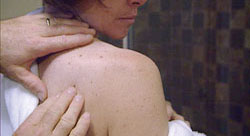Melanoma is a deadly cancer of the skin that is linked to extended exposure to radiation and UV rays. Often times, melanoma shows its symptoms by disfiguring pre-existing moles, (causing them to grow or deepen in color) or even by causing brand new growths to show on your skin. If you’re concerned about a growth that you’ve recently noticed has been growing, consult a dermatologist immediately. The mole could be malignant. Mole removal is extensive for a mole that’s malignant but it is necessary to stop the spread of cancer. If you have a benign mole, keep monitoring it as it can deform with prolonged, unprotected exposure to UV lights.

What is Melanoma
Melanoma is the most dangerous form of skin cancer that presents itself in people. It can be subtly lying dormant in the skin without showing exterior signs before diagnosis, but luckily, it will usually trigger growths and changes in birthmarks as symptoms. Other symptoms include asymmetry, weird-shaped edges and color deepening or changing in pre-existing moles.
There are four types of Melanoma including the following:
- Superficial Spreading Melanoma: This is the most prevalent kind of melanoma. You’ll find moles that are flat and weird-looking in appearance with colors ranging between black and brown. This skin condition is most often found in white (Caucasian) populations.
- Nodular Melanoma: While some are flesh-toned, these usually raise up as a bump and darken between a black/ blue-ish color.
- Lentigo Maligna Melanoma: This type of melanoma is most often found in the elderly population. It’s attributed to sun-damage to the skin after the course of a lifetime and usually presents itself on the face, neck and arms. Anomalies in the skin are usually tan colored with a few brown locations throughout.
- Acral Lentiginous Melanoma: This is the rarest melanoma type. It is typically found in odd places like on the palms, soles of feet or underneath toe or fingernails. This melanoma is more prevalent in African American communities.
While melanoma is frequently attributed to tanning without sun tanning lotion or tanning within a tanning booth, there are other causes and risks to avoid. Exposure to carcinogens such as arsenic, gasoline, coal and other chemicals can greatly increase your chances of melanoma.
Getting a Mole Removed
If you find that your mole is cancerous with melanoma or from any other serious skin condition, there are options as far as getting it removed. Speak with a dermatologist to determine the best course of action for your mole removal and the effective stop to terminal illnesses spreading in your system.
- Excision: This is the standard process of getting local anesthesia applied and having the mole cut out. With melanoma, this is a typical treatment but some centers have upgraded to laser treatment.
- Cryotherapy: Cryotherapy is the process of freezing the mole and either continuing application of a freezing spray, or performing surgery.
- Laser Treatment: The quickest and most painless process for mole removal. Often laser treatment is expensive and inaccessible leaving excision the best option.
